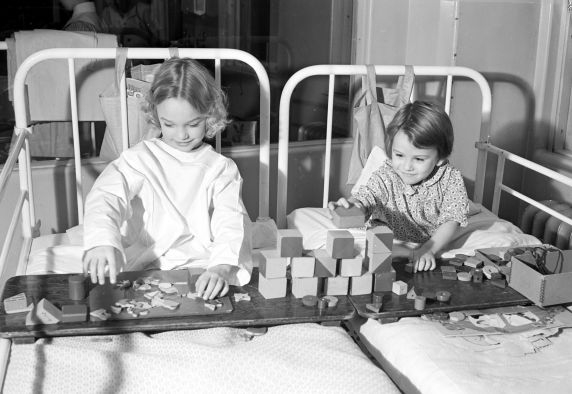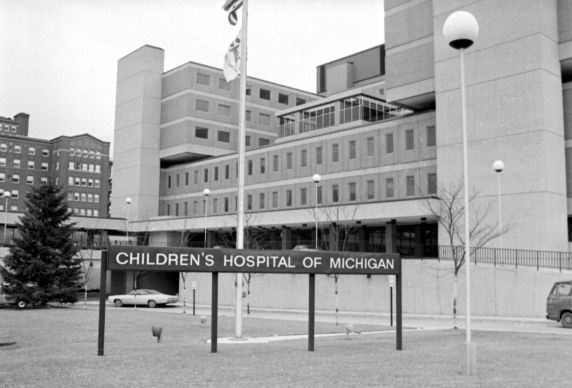History of Children's Hospital of Michigan
In the Winter 2013 semester, the Reuther Library worked with students in the Graduate Certificate in Archival Administration program at the Wayne State School of Library and Information Science to produce a series of student-written, guest blog posts.
Steve Wejroch is an MLIS student at Wayne State University studying Archival Administration.
What would become the Children’s Hospital of Michigan was established in 1886 as the Children’s Free Hospital Association. Through a financial donation by Hiram Walker, founder of the Canadian Club Whiskey distillery in present-day Windsor, Ontario, and additional financial support from prominent women of Detroit, the Children’s Free Hospital Association was established to care for the sick children of Detroit whose parents did not have the financial resources to provide them with proper medical care.
The first facility, known as the Nancy Dunn Ward, was located at Harper Hospital on John R Street in Detroit. The twelve bed infirmary was expanded two years later, when an additional twenty-two beds were added. In 1890, the Children’s Free Hospital relocated to the Caskey House, at Fort and Seventh Streets in Detroit. Additional facilities were added at the Pope House, a neighboring facility which was used to care for children suffering from contagious diseases.
The Children’s Free Hospital again needed larger facilities, but it lacked the funding for continued expansion. The hospital’s board of trustees approached Hiram Walker to request financial assistance to build a new facility. Walker purchased the land on which the hospital would be constructed and provided a donation of $125,000. He specified that $65,000 of the donation would cover construction costs and the remaining $60,000 would support hospital operations and serve as an endowment to provide for future hospital expansion.
The new hospital, which included a training school for nursemaids, opened at St. Antoine and Farnsworth Streets in 1896. By 1915, a training school for nurses, departments of social services and physical therapy, and a dental clinic were established at the facility. Additional financial support was provided by James J. Couzens, the United States Senator from Michigan, who donated one million dollars to the Children’s Free Hospital. The gift was in response to his wife’s request for a box in which to keep her pearls; Couzens presented his wife with a jewelry box containing a note which read, "My dear, your new pearls will be all of the children who are eventually treated here."
A stipulation of Couzens’s donation was that the Children’s Free Hospital was to merge with the Michigan Hospital School in Farmington. As a result of the merger, the Children’s Hospital of Michigan was established in 1922. Construction began immediately and a new hospital in Farmington was completed in 1927. Another stipulation of Couzens’s donation required that the hospital would be open to all children, not only those of limited financial means.
The growth of Children’s Hospital led to innovations in medical care for children, including the establishment of the Children’s Fund of Michigan in 1925. Founded to promote funding for research at Children’s Hospital, the Children’s Fund evolved into the Children’s Research Center by the late 1950s. In 1957, Children’s Hospital of Michigan became affiliated with the Wayne State University School of Medicine. As a result of this affiliation, the faculty and staff of the Wayne State University School of Medicine’s Department of Pediatrics serve the Children’s Hospital of Michigan by providing medical care, training and research services.
In the late 1950s, the Children’s Hospital of Michigan built its current facility in Detroit, located in the medical center area, at the St. Antoine and Farnsworth site, where it had resided in the late 19th Century. In 2013, the Children’s Hospital is a 228-bed facility, and operates as part of the Detroit Medical Center. The hospital is staffed by more than 400 physicians, 125 pediatric specialists, 680 pediatric nurses, and more than 240 residents, specialists, fellows and medical students in training. Through its outpatient facilities and rehabilitation centers throughout metropolitan Detroit, Children’s Hospital of Michigan provides medical care to approximately 95,000 children annually.
For more on this history, researchers can view the Children's Hospital of Michigan Records and the Children’s Hospital of Michigan: Director of Laboratories Records housed at the Walter P. Reuther Library of Urban Affairs. The Reuther also holds the records of many other Detroit area hospitals, including the Grace Hospital Records, the Harper Hospital Records, the 36th General Hospital Records, the JCA Sinai Hospital Records, and the Hutzel Hospital Records. Health and hospital researchers may also be interested in other collections including the Marion Josephine Wright Papers, the AFSCME Public Policy Analysis Department Records and the Richard McGhee Papers. Photographs of Children’s Hospital of Michigan and the Children’s Free Hospital can be obtained through the Virtual Motor City, digitized images from the Detroit News photograph collection.
- Public Relations Team's blog
- Login to post comments
- Printer-friendly version



 Reddit
Reddit Facebook
Facebook LinkedIn
LinkedIn